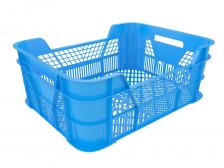How to Organize Your Stuff
Learn how to organize all of the stuff that accumulates while working on a project.

I’m studying photography and electronics. I have all kinds of items laying around in my room. Some are closely related, like lenses and camera bodies. Others are totally unrelated and I only have one of each. I bought some bins, thinking it would make sorting stuff out a lot easier. But guess what–I’m wrong! I can’t think of what labels to put on those bins. Can you help me out?
Alex has a problem. He’s a student studying photography and electronics. In fact, he’s even building a steam-powered robotic arm. Or he would, if he could find the parts. He has all kinds of items laying around. Some are closely related, like lenses and camera bodies, whereas others are totally unrelated. He bought bins, thinking it would make sorting stuff easier. And it would, except for one small problem: how should he label those bins?
How to Organize Stuff
I feel Alex’s pain. I was once a student, too, in a single, cluttered room. Now I’m a professional with an apartment that has six cluttered rooms. It makes me a really good consumer. Since I can never find anything, I just buy new stuff whenever I need it. Like umbrellas. There are between 10 and 20 of them laying around. If it weren’t for me, umbrella manufacturers would be petitioning for a bailout.
What we both need is a place for everything and everything in its place. If we need a piece of paper, we should know right where to go. When we want our books, we go to our book place. When we want email, we go to our computer hutch. When we’re trying to hatch chicken eggs for a biology project, we go to our incubator and make an offering on the altar of Heket, the Egyptian fertility frog god.
How to Organize Stuff with Bins
First of all, buy bins to keep stuff in. Don’t get bins that are too big, or you’ll waste space. Don’t get bins that are too small, or you’ll have robot arms and legs sticking out everywhere. You don’t want them coming to life to strangle you in your sleep, so you may even consider bins with lids.
Put everything involved with a single project or class together in one bin, or in bins that are side by side. That way, when you decide it’s time to work on that project or class, everything you need is at your fingertips. If it’s photography time, your camera and lenses are right there.
In your follow-up email to me, you said your steam-powered robotic arm needs a boiler from a coffee maker, gears from old watches, and a laser out of an old burner. You want to put all of those together in one bin, so they are all there when you need them. That way, you won’t accidentally disassemble your working coffee maker at the end of an all-night assembly marathon; you’ll need that coffee to make it to class!
How to Organize Stuff with Labels
Label your bins so you know what goes where. When you first put stuff in the bins, you’ll remember what goes where. In six months, though, you’ll be walking back to your room through the rain, after a bad breakup that’s the direct result of a misguided Tequila dare and you won’t have any idea which bin stores your weekly supply of hangover-B-gone. Write your labels neatly, in big letters, so you can easily read them through the tears. There’s no better way to drown your sorrows than assembling a robotic arm.
And by the way, use removable labels, so you can re-use bins for future classes.
How to Organize Similar Stuff
Some stuff isn’t related to a specific project or class. You keep it around because it might be useful for many different projects.
In your case, you have a bin with all the parts for your robotic arm. But if you plan to build hundreds of identical robots (I don’t know why you’d want to do that), you want an inventory of spare parts. Organize an inventory by grouping identical objects together. Put all the spare robotic arms in one bin. In another, put the spare eyes, and in a third, put the spare noses. Then when a robot breaks, you replace the part from the appropriate bin. And that’s how you maintain your robot army–I mean robot soccer team.
(As an electronics major, you’ve obviously realized robots are far superior to Zombies; Zombies talk back:
“Master! Let me command army.”
“Your leg fell off. You can’t defeat an enemy with only one leg.”
“Yes, Master, I can!”
“How, exactly? Hop at them and beat them over the head with the leg that fell off?”
Robots can be programmed to do exactly what you want, and they don’t need refrigeration.)
How to Organize Rarely Used Stuff
Things you’re keeping “just in case I need it someday” can be organized by very broad category because it’s more work to sort them than to find what you need when you need it. For example, I have a box labeled “Cables.” Anything even remotely cable-like goes into that box. When I need a cable, I dump out the box and go through it by hand. More organization isn’t necessary, though, since I only go into it once or twice a year.
Clean Out Your Bins at the End of a Project
When you finish a class or project, examine what’s left in the bin. If you think you’ll use an item again, save it. For example, you may have a bin of current working photography supplies where you transfer items left over from specific class. If you don’t think you’ll use it, get rid of it. Sell it to a friend who’s taking the same classes next term. Your life will be simpler and cleaner if you empty and reuse your bins, instead of collecting all kinds of stuff you’ll never actually go back and look at.
Keep your room neat by sorting everything by project. What doesn’t belong to a project gets grouped in an inventory by item. And if you have stuff you use rarely, don’t be afraid to toss it all in a “used rarely” box. When you’re done with an item, give it to someone else who can use it. Or give it as an offering to Heket. Maybe you’ll have eight babies and get your own reality TV show. Or maybe you’ll just turn turn into a frog.
Also see my episodes on:
- Cleaning your apartment quickly
- Organizing your closet
- Keeping a spotless desk
- Storing digital photos
- Busting your book backlog
Work Less, Do More, and have a Great Life!
Storage Bin image courtesy of Shutterstock


